Analysis of Hospitality Provision in Travel and Tourism Sector (TUI)
VerifiedAdded on 2020/10/05
|11
|3470
|273
Report
AI Summary
This report delves into the interconnectedness of the hospitality and travel and tourism sectors, using the TUI Group as a case study. It explores the interrelation between these sectors, highlighting how travel fuels the hospitality industry and vice versa. The report examines the implications and effects of integration within the hospitality sector, analyzing both vertical and horizontal integration strategies employed by TUI, and their impacts on cost, technology, globalization, quality, and knowledge management. Furthermore, the report includes a project proposal for a new food and beverage business, Foodies, detailing market analysis, target audience, location, and operating model, demonstrating an understanding of the current market trends and opportunities within the hospitality sector. The report concludes with a summary of the key findings and their implications for the future of the industry.
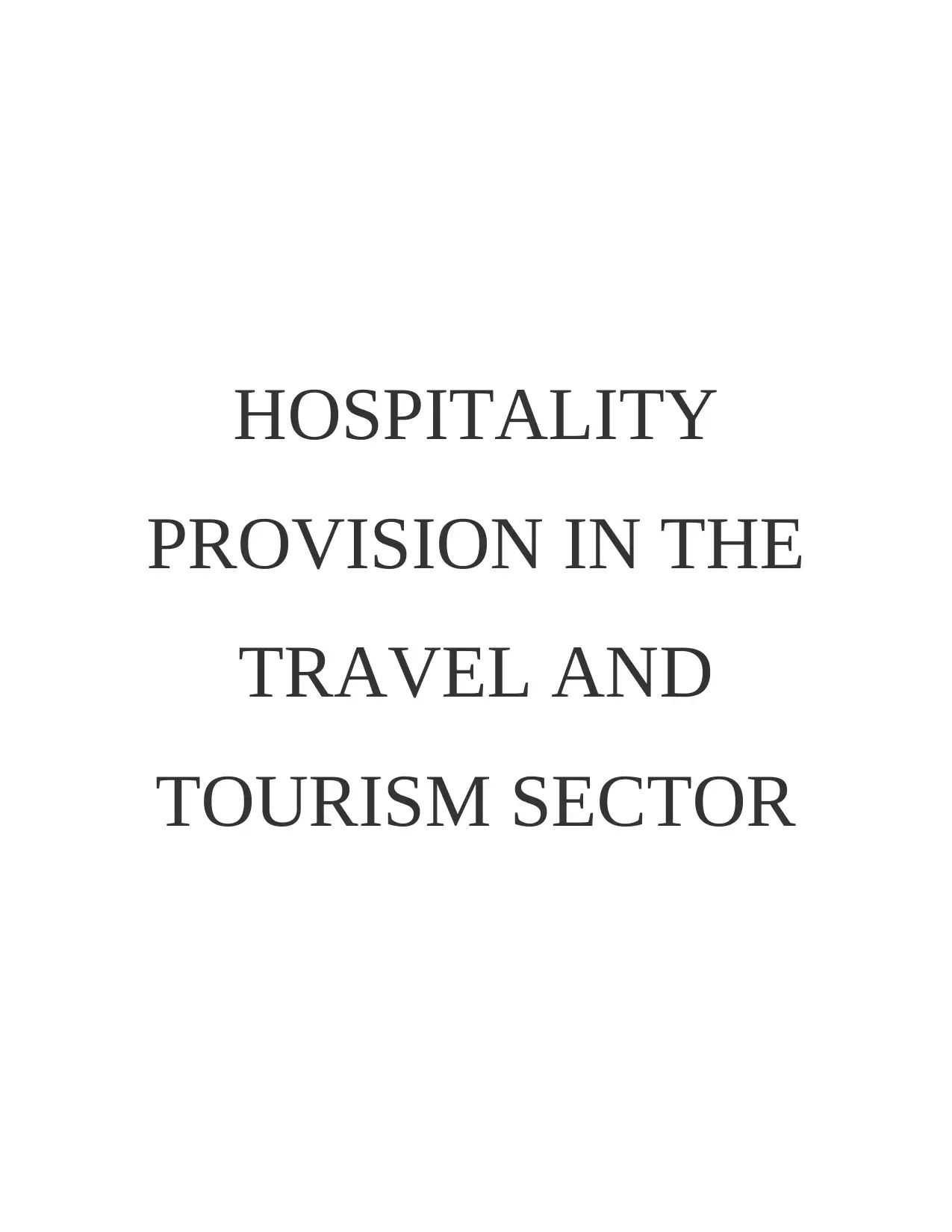
HOSPITALITY
PROVISION IN THE
TRAVEL AND
TOURISM SECTOR
PROVISION IN THE
TRAVEL AND
TOURISM SECTOR
Paraphrase This Document
Need a fresh take? Get an instant paraphrase of this document with our AI Paraphraser
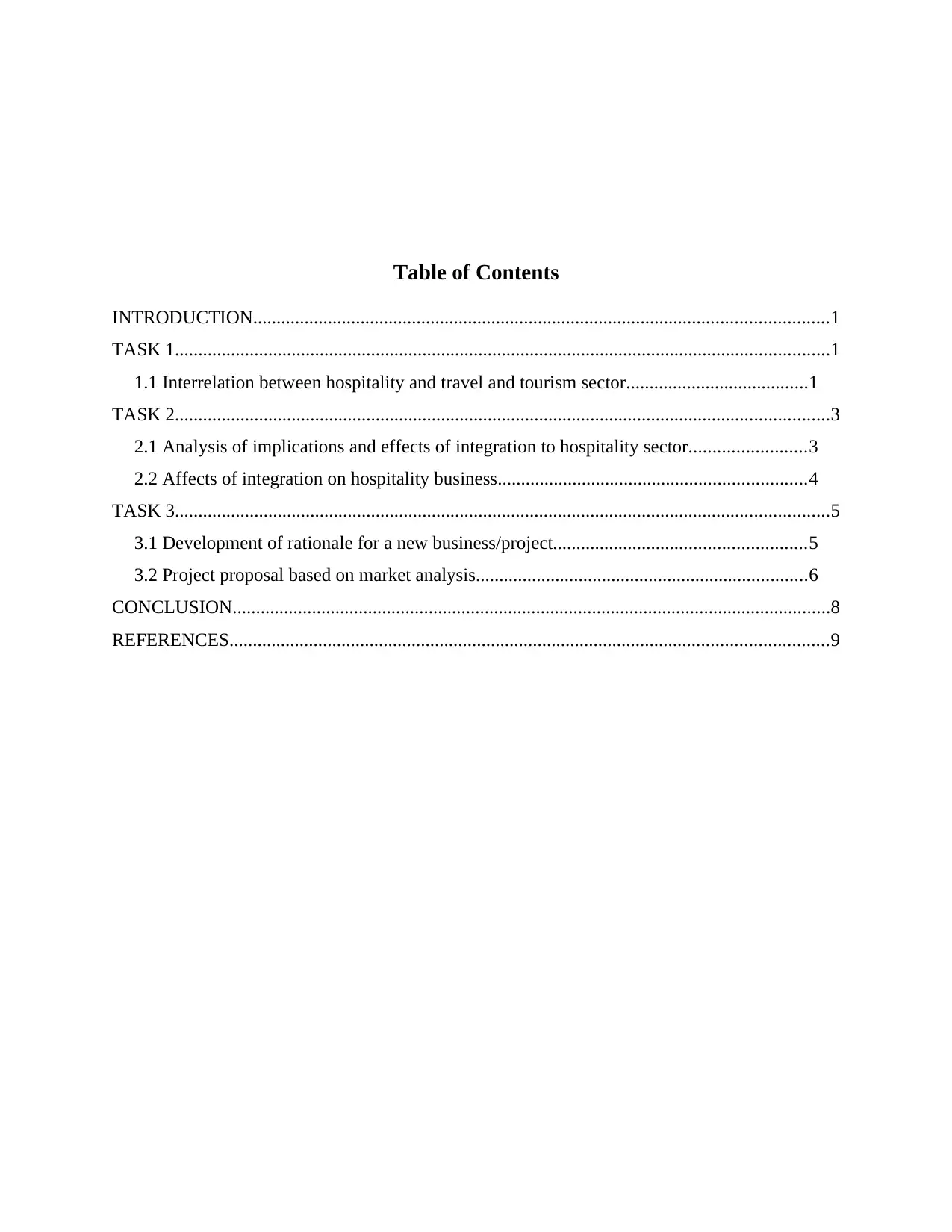
Table of Contents
INTRODUCTION...........................................................................................................................1
TASK 1............................................................................................................................................1
1.1 Interrelation between hospitality and travel and tourism sector.......................................1
TASK 2............................................................................................................................................3
2.1 Analysis of implications and effects of integration to hospitality sector.........................3
2.2 Affects of integration on hospitality business..................................................................4
TASK 3............................................................................................................................................5
3.1 Development of rationale for a new business/project......................................................5
3.2 Project proposal based on market analysis.......................................................................6
CONCLUSION................................................................................................................................8
REFERENCES................................................................................................................................9
INTRODUCTION...........................................................................................................................1
TASK 1............................................................................................................................................1
1.1 Interrelation between hospitality and travel and tourism sector.......................................1
TASK 2............................................................................................................................................3
2.1 Analysis of implications and effects of integration to hospitality sector.........................3
2.2 Affects of integration on hospitality business..................................................................4
TASK 3............................................................................................................................................5
3.1 Development of rationale for a new business/project......................................................5
3.2 Project proposal based on market analysis.......................................................................6
CONCLUSION................................................................................................................................8
REFERENCES................................................................................................................................9
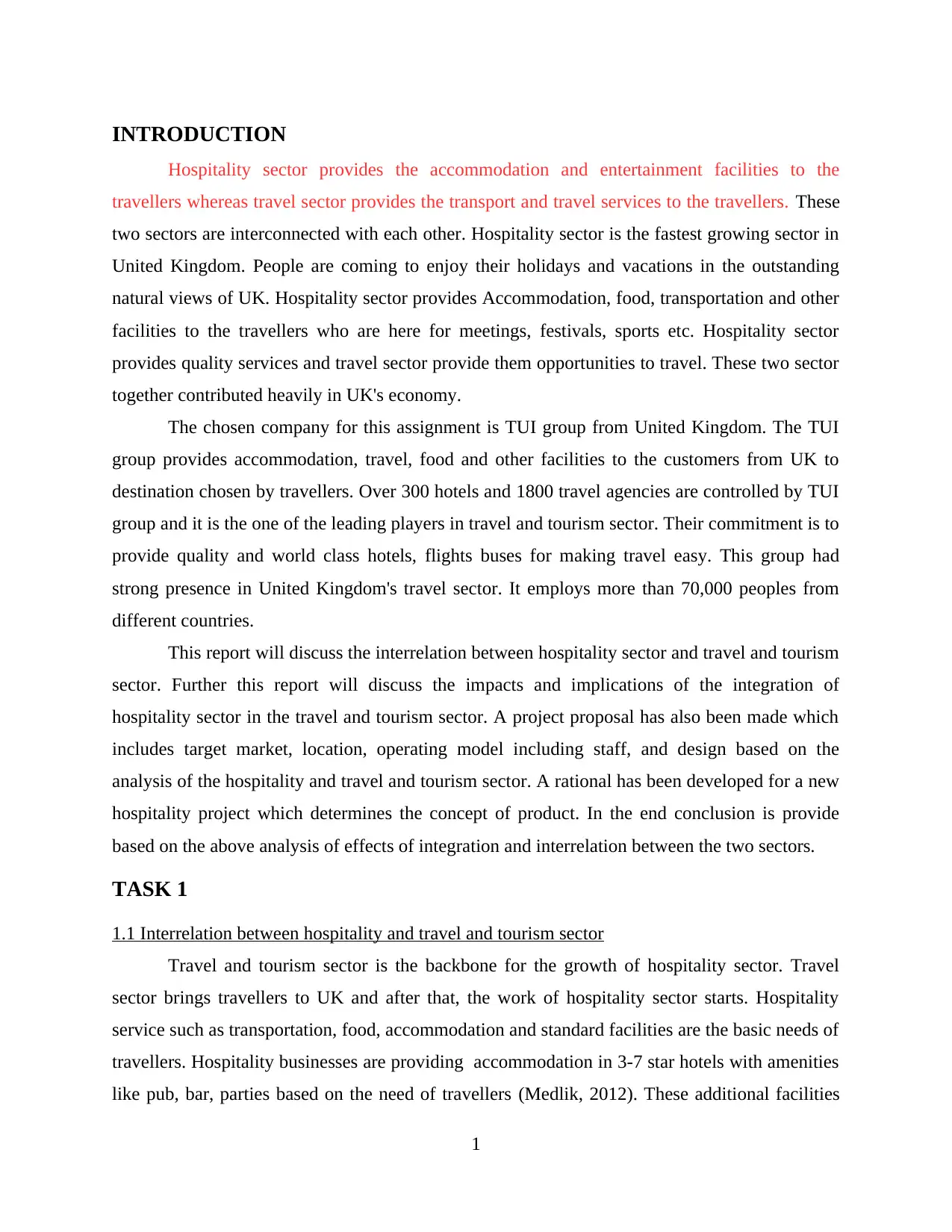
INTRODUCTION
Hospitality sector provides the accommodation and entertainment facilities to the
travellers whereas travel sector provides the transport and travel services to the travellers. These
two sectors are interconnected with each other. Hospitality sector is the fastest growing sector in
United Kingdom. People are coming to enjoy their holidays and vacations in the outstanding
natural views of UK. Hospitality sector provides Accommodation, food, transportation and other
facilities to the travellers who are here for meetings, festivals, sports etc. Hospitality sector
provides quality services and travel sector provide them opportunities to travel. These two sector
together contributed heavily in UK's economy.
The chosen company for this assignment is TUI group from United Kingdom. The TUI
group provides accommodation, travel, food and other facilities to the customers from UK to
destination chosen by travellers. Over 300 hotels and 1800 travel agencies are controlled by TUI
group and it is the one of the leading players in travel and tourism sector. Their commitment is to
provide quality and world class hotels, flights buses for making travel easy. This group had
strong presence in United Kingdom's travel sector. It employs more than 70,000 peoples from
different countries.
This report will discuss the interrelation between hospitality sector and travel and tourism
sector. Further this report will discuss the impacts and implications of the integration of
hospitality sector in the travel and tourism sector. A project proposal has also been made which
includes target market, location, operating model including staff, and design based on the
analysis of the hospitality and travel and tourism sector. A rational has been developed for a new
hospitality project which determines the concept of product. In the end conclusion is provide
based on the above analysis of effects of integration and interrelation between the two sectors.
TASK 1
1.1 Interrelation between hospitality and travel and tourism sector
Travel and tourism sector is the backbone for the growth of hospitality sector. Travel
sector brings travellers to UK and after that, the work of hospitality sector starts. Hospitality
service such as transportation, food, accommodation and standard facilities are the basic needs of
travellers. Hospitality businesses are providing accommodation in 3-7 star hotels with amenities
like pub, bar, parties based on the need of travellers (Medlik, 2012). These additional facilities
1
Hospitality sector provides the accommodation and entertainment facilities to the
travellers whereas travel sector provides the transport and travel services to the travellers. These
two sectors are interconnected with each other. Hospitality sector is the fastest growing sector in
United Kingdom. People are coming to enjoy their holidays and vacations in the outstanding
natural views of UK. Hospitality sector provides Accommodation, food, transportation and other
facilities to the travellers who are here for meetings, festivals, sports etc. Hospitality sector
provides quality services and travel sector provide them opportunities to travel. These two sector
together contributed heavily in UK's economy.
The chosen company for this assignment is TUI group from United Kingdom. The TUI
group provides accommodation, travel, food and other facilities to the customers from UK to
destination chosen by travellers. Over 300 hotels and 1800 travel agencies are controlled by TUI
group and it is the one of the leading players in travel and tourism sector. Their commitment is to
provide quality and world class hotels, flights buses for making travel easy. This group had
strong presence in United Kingdom's travel sector. It employs more than 70,000 peoples from
different countries.
This report will discuss the interrelation between hospitality sector and travel and tourism
sector. Further this report will discuss the impacts and implications of the integration of
hospitality sector in the travel and tourism sector. A project proposal has also been made which
includes target market, location, operating model including staff, and design based on the
analysis of the hospitality and travel and tourism sector. A rational has been developed for a new
hospitality project which determines the concept of product. In the end conclusion is provide
based on the above analysis of effects of integration and interrelation between the two sectors.
TASK 1
1.1 Interrelation between hospitality and travel and tourism sector
Travel and tourism sector is the backbone for the growth of hospitality sector. Travel
sector brings travellers to UK and after that, the work of hospitality sector starts. Hospitality
service such as transportation, food, accommodation and standard facilities are the basic needs of
travellers. Hospitality businesses are providing accommodation in 3-7 star hotels with amenities
like pub, bar, parties based on the need of travellers (Medlik, 2012). These additional facilities
1
⊘ This is a preview!⊘
Do you want full access?
Subscribe today to unlock all pages.

Trusted by 1+ million students worldwide
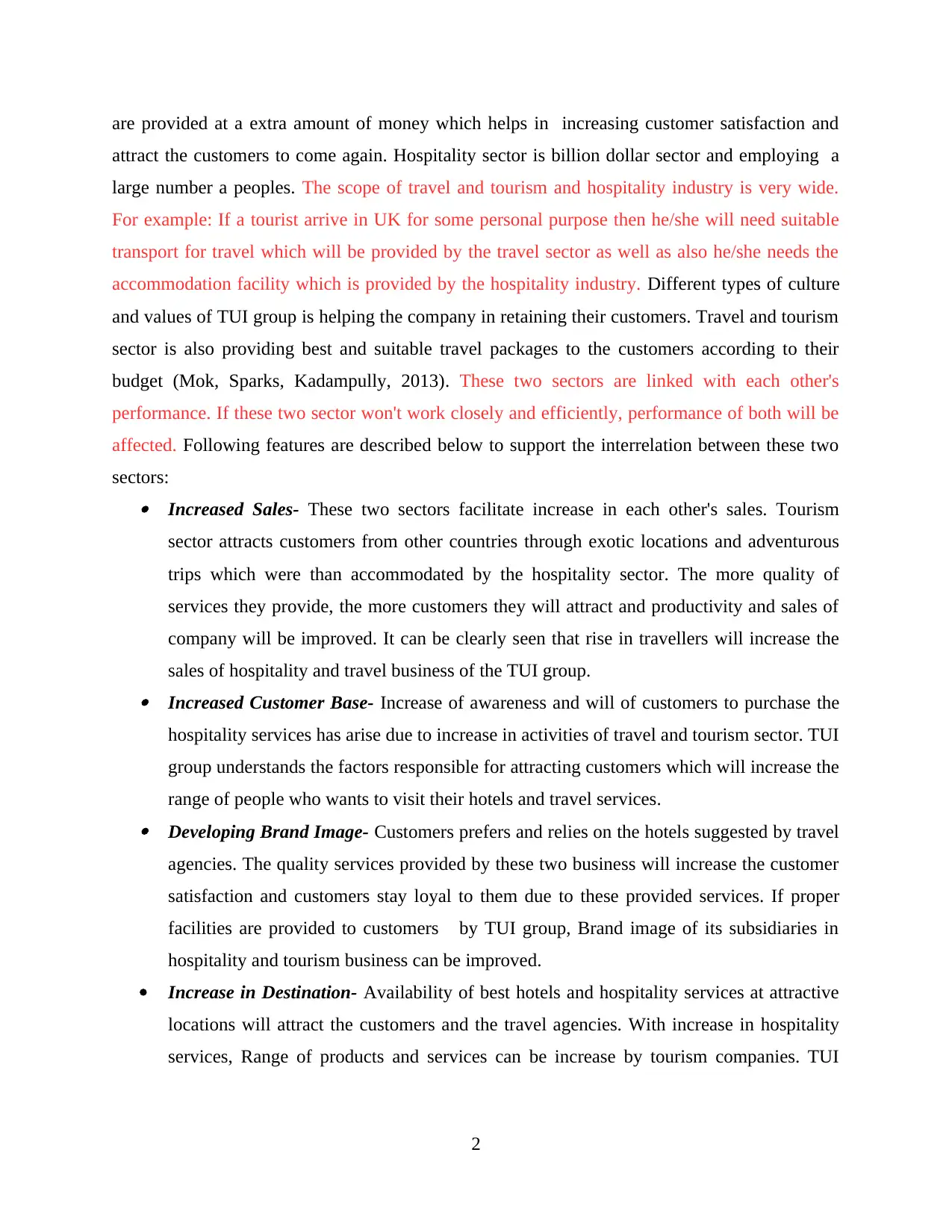
are provided at a extra amount of money which helps in increasing customer satisfaction and
attract the customers to come again. Hospitality sector is billion dollar sector and employing a
large number a peoples. The scope of travel and tourism and hospitality industry is very wide.
For example: If a tourist arrive in UK for some personal purpose then he/she will need suitable
transport for travel which will be provided by the travel sector as well as also he/she needs the
accommodation facility which is provided by the hospitality industry. Different types of culture
and values of TUI group is helping the company in retaining their customers. Travel and tourism
sector is also providing best and suitable travel packages to the customers according to their
budget (Mok, Sparks, Kadampully, 2013). These two sectors are linked with each other's
performance. If these two sector won't work closely and efficiently, performance of both will be
affected. Following features are described below to support the interrelation between these two
sectors: Increased Sales- These two sectors facilitate increase in each other's sales. Tourism
sector attracts customers from other countries through exotic locations and adventurous
trips which were than accommodated by the hospitality sector. The more quality of
services they provide, the more customers they will attract and productivity and sales of
company will be improved. It can be clearly seen that rise in travellers will increase the
sales of hospitality and travel business of the TUI group. Increased Customer Base- Increase of awareness and will of customers to purchase the
hospitality services has arise due to increase in activities of travel and tourism sector. TUI
group understands the factors responsible for attracting customers which will increase the
range of people who wants to visit their hotels and travel services. Developing Brand Image- Customers prefers and relies on the hotels suggested by travel
agencies. The quality services provided by these two business will increase the customer
satisfaction and customers stay loyal to them due to these provided services. If proper
facilities are provided to customers by TUI group, Brand image of its subsidiaries in
hospitality and tourism business can be improved.
Increase in Destination- Availability of best hotels and hospitality services at attractive
locations will attract the customers and the travel agencies. With increase in hospitality
services, Range of products and services can be increase by tourism companies. TUI
2
attract the customers to come again. Hospitality sector is billion dollar sector and employing a
large number a peoples. The scope of travel and tourism and hospitality industry is very wide.
For example: If a tourist arrive in UK for some personal purpose then he/she will need suitable
transport for travel which will be provided by the travel sector as well as also he/she needs the
accommodation facility which is provided by the hospitality industry. Different types of culture
and values of TUI group is helping the company in retaining their customers. Travel and tourism
sector is also providing best and suitable travel packages to the customers according to their
budget (Mok, Sparks, Kadampully, 2013). These two sectors are linked with each other's
performance. If these two sector won't work closely and efficiently, performance of both will be
affected. Following features are described below to support the interrelation between these two
sectors: Increased Sales- These two sectors facilitate increase in each other's sales. Tourism
sector attracts customers from other countries through exotic locations and adventurous
trips which were than accommodated by the hospitality sector. The more quality of
services they provide, the more customers they will attract and productivity and sales of
company will be improved. It can be clearly seen that rise in travellers will increase the
sales of hospitality and travel business of the TUI group. Increased Customer Base- Increase of awareness and will of customers to purchase the
hospitality services has arise due to increase in activities of travel and tourism sector. TUI
group understands the factors responsible for attracting customers which will increase the
range of people who wants to visit their hotels and travel services. Developing Brand Image- Customers prefers and relies on the hotels suggested by travel
agencies. The quality services provided by these two business will increase the customer
satisfaction and customers stay loyal to them due to these provided services. If proper
facilities are provided to customers by TUI group, Brand image of its subsidiaries in
hospitality and tourism business can be improved.
Increase in Destination- Availability of best hotels and hospitality services at attractive
locations will attract the customers and the travel agencies. With increase in hospitality
services, Range of products and services can be increase by tourism companies. TUI
2
Paraphrase This Document
Need a fresh take? Get an instant paraphrase of this document with our AI Paraphraser

group has both hotels and travel firms at various famous destinations which kept the
company running during the recession in UK due to these increases in destinations.
TASK 2
2.1 Analysis of implications and effects of integration to hospitality sector
Integration is the process of merger and acquisition for sharing the resources and
customers. Companies wants to achieve their shared goals by using latest technology and tools
for better coordination among them. TUI has also been integrated with various hotels and airlines
companies to use their shared resources. This integration will leads to expansion of company and
company can effectively and efficiently use these resources for themselves. Their combined
goals can be achieved quickly due to the integration (Boniface, Cooper, 2016). Generally
Vertical and Horizontal integrations of resources are used by TUI group as discussed below:
Vertical Integrations- It is the process of buying suppliers or a firm in distribution chain.
It leads to low cost and more profit. In vertical integration, TUI group entered into a
acquisition agreement with other firms that comes in between its distribution chain.
Through this, they would get a advantage over its competitors by increase in market share
and profit. This will help TUI to distinguish its quality services from its rivals. For
example- TUI merger with Magic life aims to provide high quality of services. The
company aims to provide equal quality services at all places. It will results in attracting
new peoples. Both of these organisation sets a single goal to achieve. This integration
won't work without the use of latest tools and technology and improvements in the supply
chain management. Management of TUI is responsible for monitoring activities and
coordination between firms.
In vertical integration, employees are finding it hard to understand the new strategies. It
results in dissatisfaction of employees as well as can face difficulties in operations. It is possible
that employees may not accept the new culture or style of working of new company. It leads to
improper communication and coordination (Smith, and Puczkó, 2014).
Horizontal Integration- It is the process of integrating two organisation to build a bigger
organisation. They provide same products and services after the merger. For example-
TUI merges with first choice airways to provide high quality of services along with
proper transport facilities. It is the way to generate huge revenue and expand the
3
company running during the recession in UK due to these increases in destinations.
TASK 2
2.1 Analysis of implications and effects of integration to hospitality sector
Integration is the process of merger and acquisition for sharing the resources and
customers. Companies wants to achieve their shared goals by using latest technology and tools
for better coordination among them. TUI has also been integrated with various hotels and airlines
companies to use their shared resources. This integration will leads to expansion of company and
company can effectively and efficiently use these resources for themselves. Their combined
goals can be achieved quickly due to the integration (Boniface, Cooper, 2016). Generally
Vertical and Horizontal integrations of resources are used by TUI group as discussed below:
Vertical Integrations- It is the process of buying suppliers or a firm in distribution chain.
It leads to low cost and more profit. In vertical integration, TUI group entered into a
acquisition agreement with other firms that comes in between its distribution chain.
Through this, they would get a advantage over its competitors by increase in market share
and profit. This will help TUI to distinguish its quality services from its rivals. For
example- TUI merger with Magic life aims to provide high quality of services. The
company aims to provide equal quality services at all places. It will results in attracting
new peoples. Both of these organisation sets a single goal to achieve. This integration
won't work without the use of latest tools and technology and improvements in the supply
chain management. Management of TUI is responsible for monitoring activities and
coordination between firms.
In vertical integration, employees are finding it hard to understand the new strategies. It
results in dissatisfaction of employees as well as can face difficulties in operations. It is possible
that employees may not accept the new culture or style of working of new company. It leads to
improper communication and coordination (Smith, and Puczkó, 2014).
Horizontal Integration- It is the process of integrating two organisation to build a bigger
organisation. They provide same products and services after the merger. For example-
TUI merges with first choice airways to provide high quality of services along with
proper transport facilities. It is the way to generate huge revenue and expand the
3
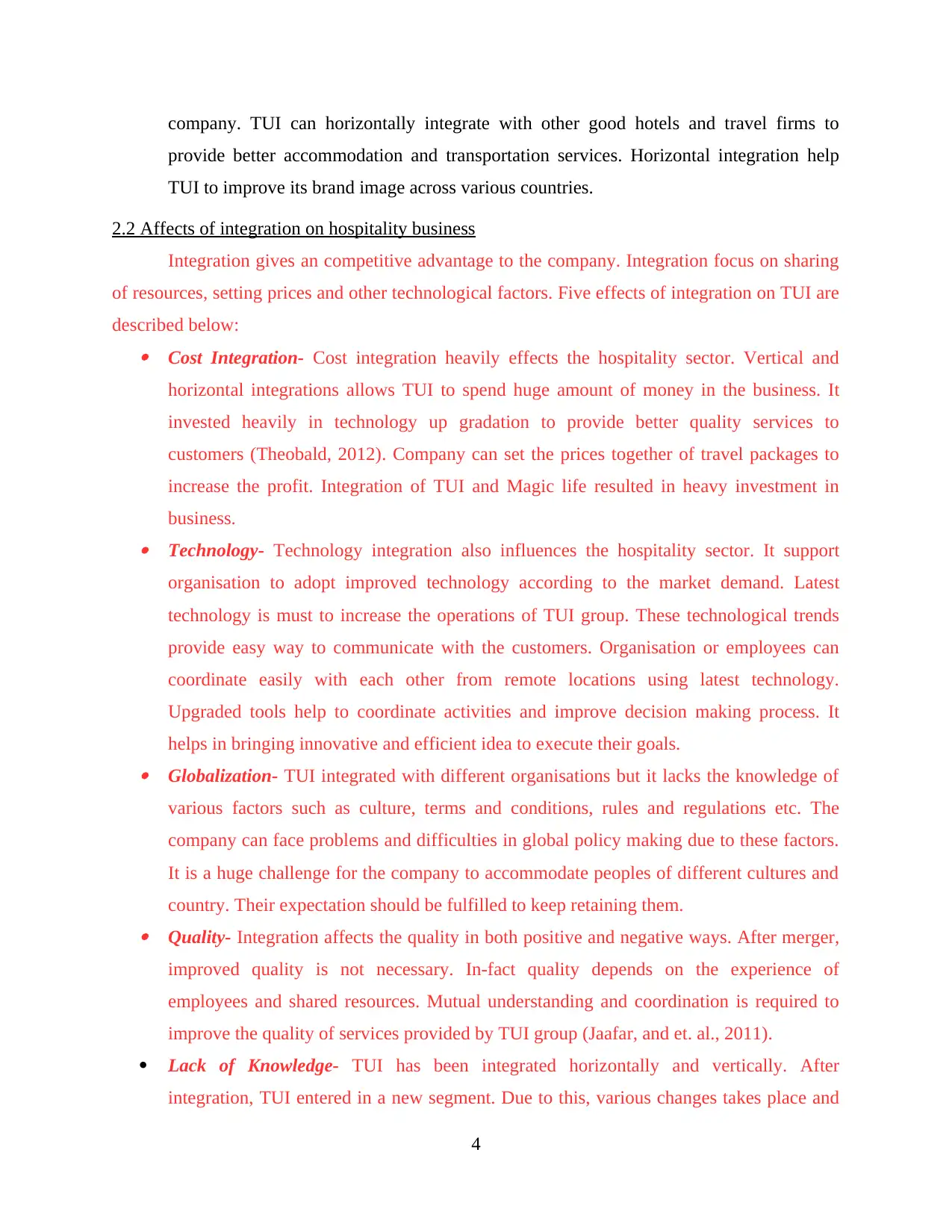
company. TUI can horizontally integrate with other good hotels and travel firms to
provide better accommodation and transportation services. Horizontal integration help
TUI to improve its brand image across various countries.
2.2 Affects of integration on hospitality business
Integration gives an competitive advantage to the company. Integration focus on sharing
of resources, setting prices and other technological factors. Five effects of integration on TUI are
described below: Cost Integration- Cost integration heavily effects the hospitality sector. Vertical and
horizontal integrations allows TUI to spend huge amount of money in the business. It
invested heavily in technology up gradation to provide better quality services to
customers (Theobald, 2012). Company can set the prices together of travel packages to
increase the profit. Integration of TUI and Magic life resulted in heavy investment in
business. Technology- Technology integration also influences the hospitality sector. It support
organisation to adopt improved technology according to the market demand. Latest
technology is must to increase the operations of TUI group. These technological trends
provide easy way to communicate with the customers. Organisation or employees can
coordinate easily with each other from remote locations using latest technology.
Upgraded tools help to coordinate activities and improve decision making process. It
helps in bringing innovative and efficient idea to execute their goals. Globalization- TUI integrated with different organisations but it lacks the knowledge of
various factors such as culture, terms and conditions, rules and regulations etc. The
company can face problems and difficulties in global policy making due to these factors.
It is a huge challenge for the company to accommodate peoples of different cultures and
country. Their expectation should be fulfilled to keep retaining them. Quality- Integration affects the quality in both positive and negative ways. After merger,
improved quality is not necessary. In-fact quality depends on the experience of
employees and shared resources. Mutual understanding and coordination is required to
improve the quality of services provided by TUI group (Jaafar, and et. al., 2011).
Lack of Knowledge- TUI has been integrated horizontally and vertically. After
integration, TUI entered in a new segment. Due to this, various changes takes place and
4
provide better accommodation and transportation services. Horizontal integration help
TUI to improve its brand image across various countries.
2.2 Affects of integration on hospitality business
Integration gives an competitive advantage to the company. Integration focus on sharing
of resources, setting prices and other technological factors. Five effects of integration on TUI are
described below: Cost Integration- Cost integration heavily effects the hospitality sector. Vertical and
horizontal integrations allows TUI to spend huge amount of money in the business. It
invested heavily in technology up gradation to provide better quality services to
customers (Theobald, 2012). Company can set the prices together of travel packages to
increase the profit. Integration of TUI and Magic life resulted in heavy investment in
business. Technology- Technology integration also influences the hospitality sector. It support
organisation to adopt improved technology according to the market demand. Latest
technology is must to increase the operations of TUI group. These technological trends
provide easy way to communicate with the customers. Organisation or employees can
coordinate easily with each other from remote locations using latest technology.
Upgraded tools help to coordinate activities and improve decision making process. It
helps in bringing innovative and efficient idea to execute their goals. Globalization- TUI integrated with different organisations but it lacks the knowledge of
various factors such as culture, terms and conditions, rules and regulations etc. The
company can face problems and difficulties in global policy making due to these factors.
It is a huge challenge for the company to accommodate peoples of different cultures and
country. Their expectation should be fulfilled to keep retaining them. Quality- Integration affects the quality in both positive and negative ways. After merger,
improved quality is not necessary. In-fact quality depends on the experience of
employees and shared resources. Mutual understanding and coordination is required to
improve the quality of services provided by TUI group (Jaafar, and et. al., 2011).
Lack of Knowledge- TUI has been integrated horizontally and vertically. After
integration, TUI entered in a new segment. Due to this, various changes takes place and
4
⊘ This is a preview!⊘
Do you want full access?
Subscribe today to unlock all pages.

Trusted by 1+ million students worldwide
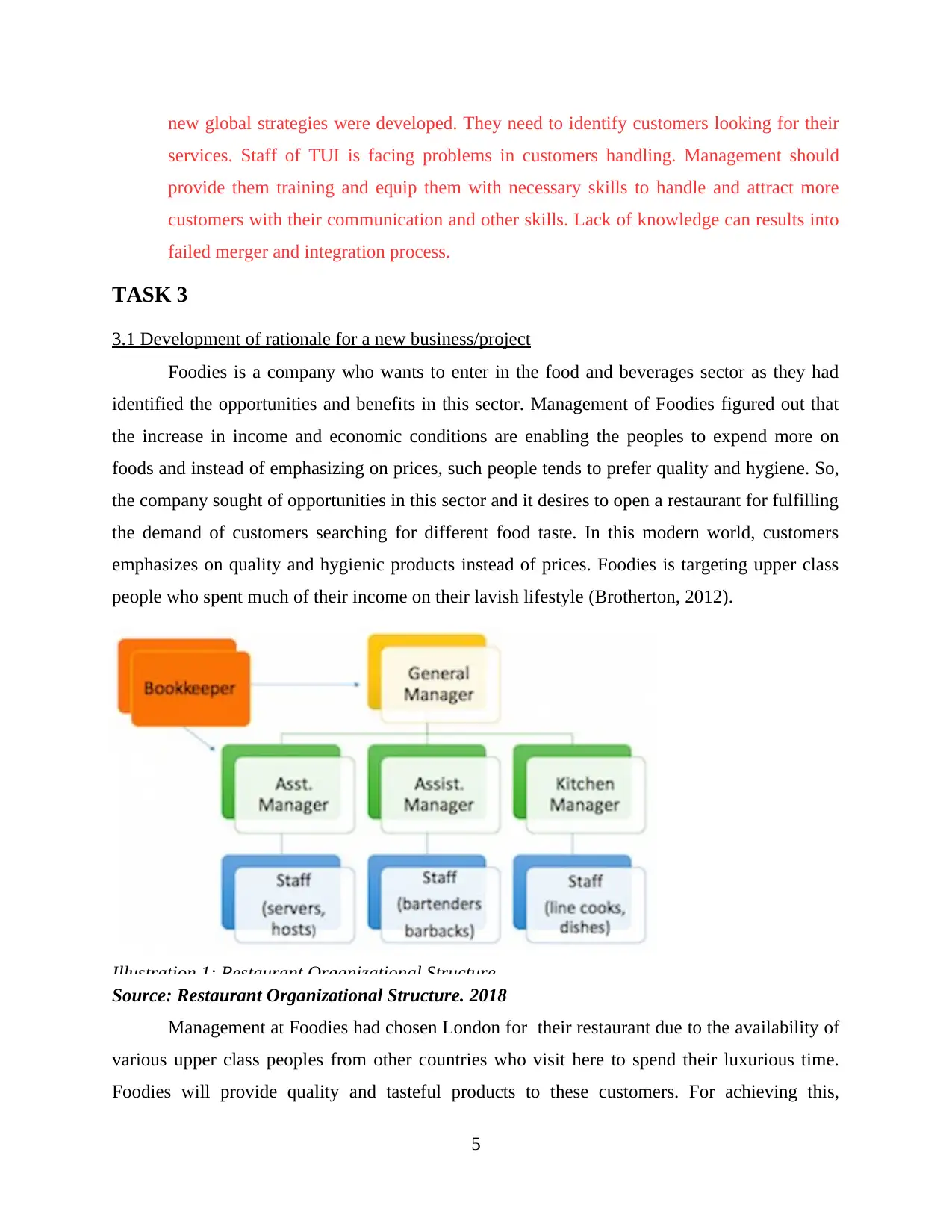
new global strategies were developed. They need to identify customers looking for their
services. Staff of TUI is facing problems in customers handling. Management should
provide them training and equip them with necessary skills to handle and attract more
customers with their communication and other skills. Lack of knowledge can results into
failed merger and integration process.
TASK 3
3.1 Development of rationale for a new business/project
Foodies is a company who wants to enter in the food and beverages sector as they had
identified the opportunities and benefits in this sector. Management of Foodies figured out that
the increase in income and economic conditions are enabling the peoples to expend more on
foods and instead of emphasizing on prices, such people tends to prefer quality and hygiene. So,
the company sought of opportunities in this sector and it desires to open a restaurant for fulfilling
the demand of customers searching for different food taste. In this modern world, customers
emphasizes on quality and hygienic products instead of prices. Foodies is targeting upper class
people who spent much of their income on their lavish lifestyle (Brotherton, 2012).
Illustration 1: Restaurant Organizational Structure
Source: Restaurant Organizational Structure. 2018
Management at Foodies had chosen London for their restaurant due to the availability of
various upper class peoples from other countries who visit here to spend their luxurious time.
Foodies will provide quality and tasteful products to these customers. For achieving this,
5
services. Staff of TUI is facing problems in customers handling. Management should
provide them training and equip them with necessary skills to handle and attract more
customers with their communication and other skills. Lack of knowledge can results into
failed merger and integration process.
TASK 3
3.1 Development of rationale for a new business/project
Foodies is a company who wants to enter in the food and beverages sector as they had
identified the opportunities and benefits in this sector. Management of Foodies figured out that
the increase in income and economic conditions are enabling the peoples to expend more on
foods and instead of emphasizing on prices, such people tends to prefer quality and hygiene. So,
the company sought of opportunities in this sector and it desires to open a restaurant for fulfilling
the demand of customers searching for different food taste. In this modern world, customers
emphasizes on quality and hygienic products instead of prices. Foodies is targeting upper class
people who spent much of their income on their lavish lifestyle (Brotherton, 2012).
Illustration 1: Restaurant Organizational Structure
Source: Restaurant Organizational Structure. 2018
Management at Foodies had chosen London for their restaurant due to the availability of
various upper class peoples from other countries who visit here to spend their luxurious time.
Foodies will provide quality and tasteful products to these customers. For achieving this,
5
Paraphrase This Document
Need a fresh take? Get an instant paraphrase of this document with our AI Paraphraser
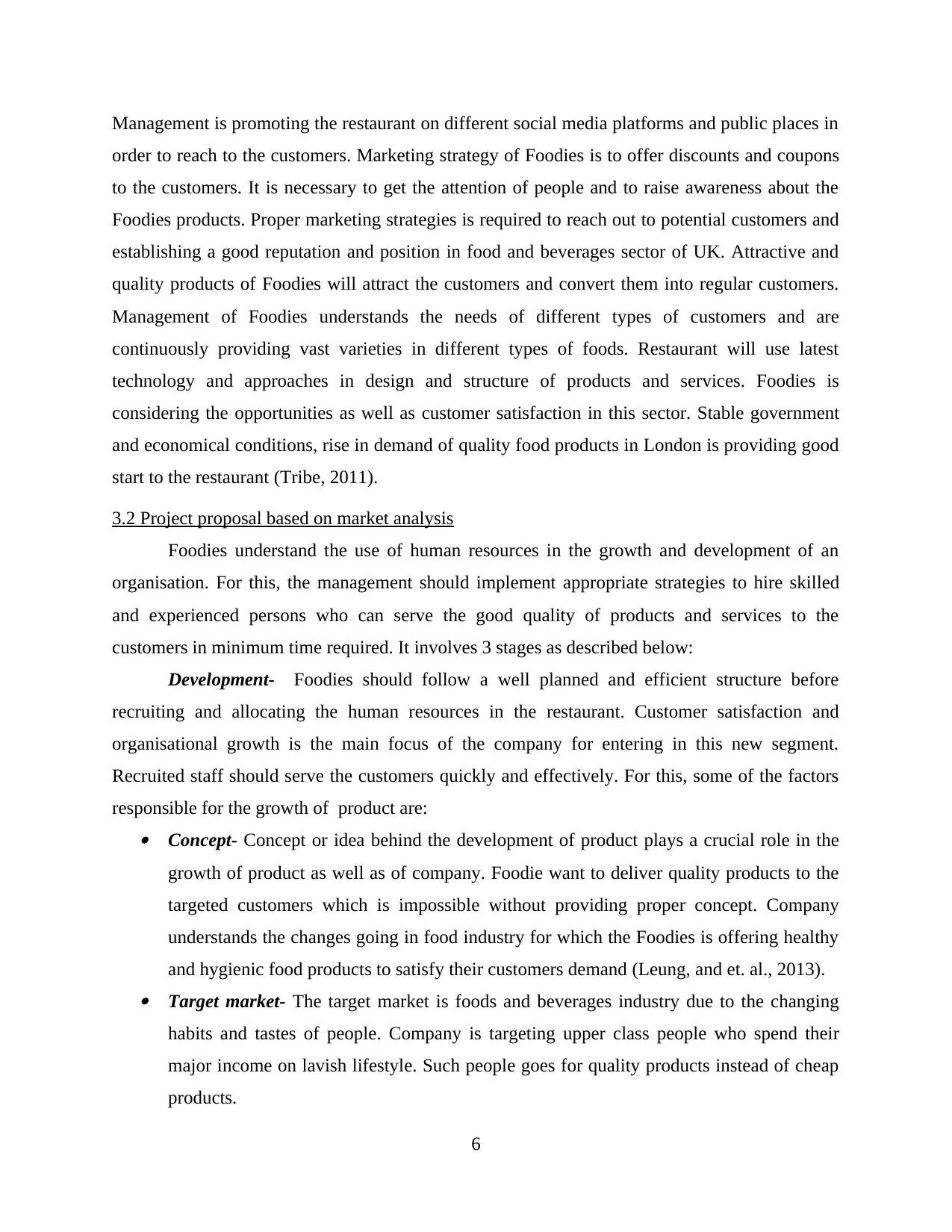
Management is promoting the restaurant on different social media platforms and public places in
order to reach to the customers. Marketing strategy of Foodies is to offer discounts and coupons
to the customers. It is necessary to get the attention of people and to raise awareness about the
Foodies products. Proper marketing strategies is required to reach out to potential customers and
establishing a good reputation and position in food and beverages sector of UK. Attractive and
quality products of Foodies will attract the customers and convert them into regular customers.
Management of Foodies understands the needs of different types of customers and are
continuously providing vast varieties in different types of foods. Restaurant will use latest
technology and approaches in design and structure of products and services. Foodies is
considering the opportunities as well as customer satisfaction in this sector. Stable government
and economical conditions, rise in demand of quality food products in London is providing good
start to the restaurant (Tribe, 2011).
3.2 Project proposal based on market analysis
Foodies understand the use of human resources in the growth and development of an
organisation. For this, the management should implement appropriate strategies to hire skilled
and experienced persons who can serve the good quality of products and services to the
customers in minimum time required. It involves 3 stages as described below:
Development- Foodies should follow a well planned and efficient structure before
recruiting and allocating the human resources in the restaurant. Customer satisfaction and
organisational growth is the main focus of the company for entering in this new segment.
Recruited staff should serve the customers quickly and effectively. For this, some of the factors
responsible for the growth of product are: Concept- Concept or idea behind the development of product plays a crucial role in the
growth of product as well as of company. Foodie want to deliver quality products to the
targeted customers which is impossible without providing proper concept. Company
understands the changes going in food industry for which the Foodies is offering healthy
and hygienic food products to satisfy their customers demand (Leung, and et. al., 2013). Target market- The target market is foods and beverages industry due to the changing
habits and tastes of people. Company is targeting upper class people who spend their
major income on lavish lifestyle. Such people goes for quality products instead of cheap
products.
6
order to reach to the customers. Marketing strategy of Foodies is to offer discounts and coupons
to the customers. It is necessary to get the attention of people and to raise awareness about the
Foodies products. Proper marketing strategies is required to reach out to potential customers and
establishing a good reputation and position in food and beverages sector of UK. Attractive and
quality products of Foodies will attract the customers and convert them into regular customers.
Management of Foodies understands the needs of different types of customers and are
continuously providing vast varieties in different types of foods. Restaurant will use latest
technology and approaches in design and structure of products and services. Foodies is
considering the opportunities as well as customer satisfaction in this sector. Stable government
and economical conditions, rise in demand of quality food products in London is providing good
start to the restaurant (Tribe, 2011).
3.2 Project proposal based on market analysis
Foodies understand the use of human resources in the growth and development of an
organisation. For this, the management should implement appropriate strategies to hire skilled
and experienced persons who can serve the good quality of products and services to the
customers in minimum time required. It involves 3 stages as described below:
Development- Foodies should follow a well planned and efficient structure before
recruiting and allocating the human resources in the restaurant. Customer satisfaction and
organisational growth is the main focus of the company for entering in this new segment.
Recruited staff should serve the customers quickly and effectively. For this, some of the factors
responsible for the growth of product are: Concept- Concept or idea behind the development of product plays a crucial role in the
growth of product as well as of company. Foodie want to deliver quality products to the
targeted customers which is impossible without providing proper concept. Company
understands the changes going in food industry for which the Foodies is offering healthy
and hygienic food products to satisfy their customers demand (Leung, and et. al., 2013). Target market- The target market is foods and beverages industry due to the changing
habits and tastes of people. Company is targeting upper class people who spend their
major income on lavish lifestyle. Such people goes for quality products instead of cheap
products.
6

Location- The location of the restaurant is London. Company chose this location due to
the number of visitors from various countries who came for spending their quality time.
Even this city has the most number of upper class people whom the company is targeting.
Fulfilling the needs of these customers will leads to increase in productivity of company.
Design- It describe the outer and inner look of the organisation or product. Attractive
design in interior and exterior helps in attracting more customers (Roberts, Hall, and Morag,
2017). Several factors influences the performance of product and company which are discussed
below: Culture- It is the basic identification of restaurant. Good culture of restaurant attracts
customers so management needs to put more efforts for good culture. Workers should
have skills and knowledge to behave properly to the customers. Customers from outside
UK can enjoy the feel of UK's culture during their visit to restaurant. Sustainability- Foodies should provide offers and discounts to existing customers for
sustaining in the market. Company should revise the market conditions and use
appropriate strategies to sustain in the food industry. Interior and exterior- The physical designs of product and restaurant can be helpful in
converting visitors to regular customers. These design should be well furnished so that
the standard of the restaurant will attract more customers. For this purpose, Foodies is
planning to use glasses, lights and garden look for retaining these visitors.
Operations- It is the process of implementing development and design stage to the
product development. Operations of Foodies will directly effect the performance of restaurant
(Teng, 2011). More productivity can be achieved using appropriate strategies. Staffing- It is necessary for allocating proper work based on the skills of employees.
Various training and workshops should be organised to equip the employees with right
skills. Foodies should staff the employees for receptionist, waiters, chefs, cleaners,
managers etc. based on their skills and experiences. Cultural diversity- Foodies should provide diversified work culture and environment for
positive response from employees and customers. Employees from various culture needs
to be treated equally and unbiased. Right policies and strategies should be implemented
to manage the diversified environment from lower level to higher level.
7
the number of visitors from various countries who came for spending their quality time.
Even this city has the most number of upper class people whom the company is targeting.
Fulfilling the needs of these customers will leads to increase in productivity of company.
Design- It describe the outer and inner look of the organisation or product. Attractive
design in interior and exterior helps in attracting more customers (Roberts, Hall, and Morag,
2017). Several factors influences the performance of product and company which are discussed
below: Culture- It is the basic identification of restaurant. Good culture of restaurant attracts
customers so management needs to put more efforts for good culture. Workers should
have skills and knowledge to behave properly to the customers. Customers from outside
UK can enjoy the feel of UK's culture during their visit to restaurant. Sustainability- Foodies should provide offers and discounts to existing customers for
sustaining in the market. Company should revise the market conditions and use
appropriate strategies to sustain in the food industry. Interior and exterior- The physical designs of product and restaurant can be helpful in
converting visitors to regular customers. These design should be well furnished so that
the standard of the restaurant will attract more customers. For this purpose, Foodies is
planning to use glasses, lights and garden look for retaining these visitors.
Operations- It is the process of implementing development and design stage to the
product development. Operations of Foodies will directly effect the performance of restaurant
(Teng, 2011). More productivity can be achieved using appropriate strategies. Staffing- It is necessary for allocating proper work based on the skills of employees.
Various training and workshops should be organised to equip the employees with right
skills. Foodies should staff the employees for receptionist, waiters, chefs, cleaners,
managers etc. based on their skills and experiences. Cultural diversity- Foodies should provide diversified work culture and environment for
positive response from employees and customers. Employees from various culture needs
to be treated equally and unbiased. Right policies and strategies should be implemented
to manage the diversified environment from lower level to higher level.
7
⊘ This is a preview!⊘
Do you want full access?
Subscribe today to unlock all pages.

Trusted by 1+ million students worldwide

Promotional activities- Various promotional activities should be offered by management
in order to attract more customers. Discounts and coupons through social media and
public places should be made available to the customers. All these marketing strategies
will effects the behaviour of customers and they tends to attract more towards the
restaurant (Boella, and Goss-Turner, 2013).
Pricing- Pricing of the products should be done according to the customers behaviour.
Foodies management should use feedbacks from the customers for fair pricing. Also the
company should follow the rules and regulations while doing so. The targeted upper class
people emphasizes less on prices while they tend to go for quality based products.
CONCLUSION
From this report, it has been concluded that hospitality business of United Kingdom is
helping the economic GDP of the country. The Hospitality and travel and tourism sector of UK
is closely associated with each other and change in performance of one, effects the performance
of other. Integration helps organisation to share their resources and work force in order to
provide better services. From this report, two type of integration i.e. horizontal and vertical are
analysed with respect to TUI Group. Various factors such as technology, cost, lack of
knowledge, quality effects the hospitality sector (Morrison, 2013). From this report, a rational
has been developed for a new hospitality project which outlines the concept of product-services.
The study also developed a project proposal based on market analysis which includes the three
stages I.e. Development, Design and Operations along with their various other factors.
8
in order to attract more customers. Discounts and coupons through social media and
public places should be made available to the customers. All these marketing strategies
will effects the behaviour of customers and they tends to attract more towards the
restaurant (Boella, and Goss-Turner, 2013).
Pricing- Pricing of the products should be done according to the customers behaviour.
Foodies management should use feedbacks from the customers for fair pricing. Also the
company should follow the rules and regulations while doing so. The targeted upper class
people emphasizes less on prices while they tend to go for quality based products.
CONCLUSION
From this report, it has been concluded that hospitality business of United Kingdom is
helping the economic GDP of the country. The Hospitality and travel and tourism sector of UK
is closely associated with each other and change in performance of one, effects the performance
of other. Integration helps organisation to share their resources and work force in order to
provide better services. From this report, two type of integration i.e. horizontal and vertical are
analysed with respect to TUI Group. Various factors such as technology, cost, lack of
knowledge, quality effects the hospitality sector (Morrison, 2013). From this report, a rational
has been developed for a new hospitality project which outlines the concept of product-services.
The study also developed a project proposal based on market analysis which includes the three
stages I.e. Development, Design and Operations along with their various other factors.
8
Paraphrase This Document
Need a fresh take? Get an instant paraphrase of this document with our AI Paraphraser

REFERENCES
Books & Journals
Boella, M. and Goss-Turner, S., 2013. Human resource management in the hospitality industry:
A guide to best practice. Routledge.
Boniface, B., Cooper, R. and Cooper, C., 2016. Worldwide destinations: The geography of travel
and tourism. Routledge.
Brotherton, B. ed., 2012. International Hospitality Industry. Routledge.
Jaafar, M., and et. al., 2011. Entrepreneurship in the tourism industry: Issues in developing
countries. International Journal of Hospitality Management. 30(4). pp.827-835.
Leung, D., and et. al., 2013. Social media in tourism and hospitality: A literature review. Journal
of travel & tourism marketing, 30(1-2), pp.3-22.
Medlik, S., 2012. Dictionary of travel, tourism and hospitality. Routledge.
Mok, C., Sparks, B. and Kadampully, J., 2013. Service quality management in hospitality,
tourism, and leisure. Routledge.
Morrison, A.M., 2013. Marketing and managing tourism destinations. Routledge.
Roberts, L., Hall, D. and Morag, M., 2017. New directions in rural tourism. Routledge.
Smith, M. and Puczkó, L., 2014. Health, tourism and hospitality: Spas, wellness and medical
travel. Routledge.
Teng, C. C., 2011. Commercial hospitality in restaurants and tourist accommodation:
Perspectives from international consumer experience in Scotland. International Journal
of Hospitality Management, 30(4), pp.866-874.
Theobald, W. F. ed., 2012. Global tourism. Routledge.
Tribe, J., 2011. The economics of recreation, leisure and tourism. Routledge.
Online:
Restaurant Organizational Structure. 2018. [Online]. Available
through:<https://study.com/academy/lesson/restaurant-organizational-structure.html>
9
Books & Journals
Boella, M. and Goss-Turner, S., 2013. Human resource management in the hospitality industry:
A guide to best practice. Routledge.
Boniface, B., Cooper, R. and Cooper, C., 2016. Worldwide destinations: The geography of travel
and tourism. Routledge.
Brotherton, B. ed., 2012. International Hospitality Industry. Routledge.
Jaafar, M., and et. al., 2011. Entrepreneurship in the tourism industry: Issues in developing
countries. International Journal of Hospitality Management. 30(4). pp.827-835.
Leung, D., and et. al., 2013. Social media in tourism and hospitality: A literature review. Journal
of travel & tourism marketing, 30(1-2), pp.3-22.
Medlik, S., 2012. Dictionary of travel, tourism and hospitality. Routledge.
Mok, C., Sparks, B. and Kadampully, J., 2013. Service quality management in hospitality,
tourism, and leisure. Routledge.
Morrison, A.M., 2013. Marketing and managing tourism destinations. Routledge.
Roberts, L., Hall, D. and Morag, M., 2017. New directions in rural tourism. Routledge.
Smith, M. and Puczkó, L., 2014. Health, tourism and hospitality: Spas, wellness and medical
travel. Routledge.
Teng, C. C., 2011. Commercial hospitality in restaurants and tourist accommodation:
Perspectives from international consumer experience in Scotland. International Journal
of Hospitality Management, 30(4), pp.866-874.
Theobald, W. F. ed., 2012. Global tourism. Routledge.
Tribe, J., 2011. The economics of recreation, leisure and tourism. Routledge.
Online:
Restaurant Organizational Structure. 2018. [Online]. Available
through:<https://study.com/academy/lesson/restaurant-organizational-structure.html>
9
1 out of 11
Related Documents
Your All-in-One AI-Powered Toolkit for Academic Success.
+13062052269
info@desklib.com
Available 24*7 on WhatsApp / Email
![[object Object]](/_next/static/media/star-bottom.7253800d.svg)
Unlock your academic potential
Copyright © 2020–2025 A2Z Services. All Rights Reserved. Developed and managed by ZUCOL.





